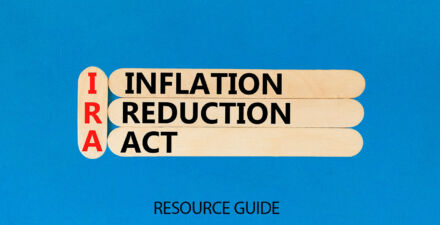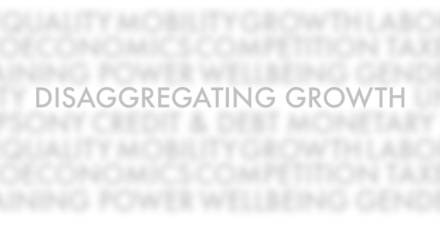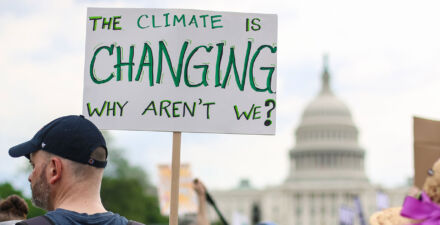Advancing economic research on the Inflation Reduction Act: Q&A with Heather Boushey

The Inflation Reduction Act of 2022 is the most significant economic and clean energy jobs program the United States has ever initiated. To improve overall understanding of whether the new law has been effective in achieving its economic policy goals, the Washington Center for Equitable Growth is engaging with policymakers and academics to discuss evaluation and research opportunities that have emerged since its implementation. Through the release of our Request for Proposals: The economic effects of the Inflation Reduction Act, our goal is to stimulate new research on the law’s impact on local and regional labor markets, job creation, innovation, and investment.
Improving models, particularly better integration of climate and economic research frameworks, will be essential to measuring and evaluating the macroeconomic effects of the Inflation Reduction Act. To that end, we’ve asked Heather Boushey what scholars should consider when designing research to study the distributional economic outcomes of the Inflation Reduction Act. Boushey served as the chief economist for the Invest in America Cabinet at the White House and member of the Council of Economic Advisers from 2021–2025. She was deeply involved in the design and implementation of the Inflation Reduction Act. (Boushey was also the founding President and CEO of Equitable Growth and currently serves on the organization’s Steering Committee.)
The Q&A below is intended to serve as a resource for academics seeking to sharpen their research questions on the law and its impact. The conversation touched upon the following main themes:
- Improving economic and climate modeling
- Best practices for evaluating policy effectiveness
- Measuring the macroeconomic and fiscal impacts of IRA investments
Improving economic and climate modeling
Equitable Growth: How did your time in government shape your current view on the effectiveness of existing economic and climate models?
Boushey: In my time in the White House, with my colleagues at the Office of Management and Budget, I led the Biden administration’s work to “develop methodologies to quantify climate risk within the economic assumptions and the long-term budget projections of the President’s Budget,” as laid out in the president’s Executive Order on Climate-Related Financial Risk. Working with the teams at the Council of Economic Advisers and the Office of Management and Budget, we created an interagency technical working group that wrote three major reports on new methodologies. These reports culminated in a memo to relevant federal agencies to support the quantification, assessment, and management of economic and financial climate risks.
As part of this work, we engaged key stakeholders, hosting convenings with macroeconomic forecasters, initiating a National Academy of Sciences workshop on macroeconomics and climate-related risks and opportunities, and partnering with our colleagues at the Treasury Department to engage the global economics community through a series of multilateral meetings and events.
There is much work to be done on modeling; I would point researchers to a few documents we produced that are laid out in this issue brief. Specifically, the White Papers we produced over the years assess the landscape, identify how we could rethink the models, and put these ideas into practice by laying out a rich research agenda.
Equitable Growth: What is missing from the models available to policymakers, and how can researchers help improve them for the future?
Boushey: We laid this out in the joint memo I just mentioned from the Council of Economic Advisers, Office of Management and Budget, and Treasury Department. The memo identifies priority areas for improving federal modeling and data tools to better integrate climate risks into economic policymaking.
Specifically, this memo suggests that macroeconomic modeling tools: “1) include nonprice policies 2) account for transitional dynamics and frictions, 3) account for interaction between physical and transition risks, 4) account for effects on particular income groups, subnational units, and subsectors of the economy, 5) account for extreme risk events, and 6) include short- and intermediate-term timescales and greater spatial granularity.”
Best practices for evaluating policy effectiveness
Equitable Growth: What is your perspective on emerging strategies for evaluating the effectiveness of policy levers at the intersection of decarbonization and economic growth? How can researchers help study those effects both nationally and regionally?
Boushey: We need to do more to build a new community of practice, connecting energy modelers with economists who understand supply chains, finance, and labor markets. Equitable Growth could play a role, bringing in economists with these areas of expertise.
Several efforts in support of that goal are being launched by those thinking about these questions. For example, in 2024, the Earth Fund, together with the U.S. Department of the Treasury, the Danish Finance Ministry, and the Coalition of Finance Ministers for Climate Action, hosted the first Forum on the Macroeconomics of Green and Resilient Transitions in Washington, DC. The forum provided a community platform for finance ministries to lay out their emerging analytical needs, and it allowed modelers and analysts to showcase new methods and new data for meeting those needs.
A 2023 conference and 2024 report from the Peterson Institute for International Economics elevates a variety of economic concerns [with addressing climate change]. And the conclusion of the National Academy of Sciences Roundtable on Macroeconomics and Climate-related Risks and Opportunities laid out some ideas as well.
Measuring the macroeconomic and fiscal impacts of IRA investments
Equitable Growth: Many researchers studying the Inflation Reduction Act have suggested that the macroeconomic effects of IRA investments will be minimal and potentially not worth studying further. If you agree with that sentiment, what macroeconomics questions should researchers seek to answer moving forward?
Boushey: I would like to see more investigation on several questions. Why did macroeconomic forecasts consistently underpredict the investment boom from the Bipartisan Infrastructure Law, the CHIPS and Science Act, and the Inflation Reduction Act? Are these models capable of assessing the potential effects of transformational change? If not, how are we to understand the potential economic effects—or lack thereof—of a swift transition to clean energy?
What are the medium- to long-term effects of building—or not building—a clean energy economy on productivity and growth? Do we need to find new ways to assess this outside of current macro tools?
Prior leaps in economic growth have been associated with innovations in energy that required public investment to solve market failures and become general purpose technologies. How do we think about medium- to long-term economic growth within this historical context as we confront new clean energy technologies?
We hope this Q&A helps researchers sharpen their questions and approaches to studying the economic implications of the Inflation Reduction Act. Learn more about our current funding opportunity through Equitable Growth’s Request for Proposals: The economic effects of the Inflation Reduction Act.
Did you find this content informative and engaging?
Get updates and stay in tune with U.S. economic inequality and growth!







